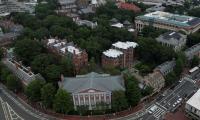LAHORE: The history and concept of local bodies in Pakistan dates back to October 26, 1959, when the military ruler of the time, Field Marshal Ayub Khan, had introduced his “Basic Democracy” (BD) System, research conducted by the "Jang Group and Geo Television Network" reveals.
However, just for the sake of knowledge, local governments have existed in the Indian subcontinent since the setting up of the first municipal corporation in Madras in 1688 by the East India Company.
The 80,000 BD representatives during Ayub’s reign were soon given the right/power to elect the president and members of the Parliament. On February 15, 1960, Ayub Khan had sought vote of confidence from the BD members, of which 75,283 or 95.6 per cent had voted in his favour.
Ayub Khan was hence sworn in as the first “elected” President of Pakistan. The referendum’s question was, “Do you have confidence in the President Field Marshal Ayub Khan?” According to the Madrid-based “Research Unit on International Security and Cooperation” (UNISCI), Commonwealth Local Government Forum, Harvard University research papers, numerous books authored by Pakistani historians and World Bank etc, these BD members then proceeded to elect the representative of the people to National Assembly in April 1962 and to the provincial assembly in May 1962.
The first session of the National Assembly was held on June 8, 1962. Soon, it was obvious that there were political groupings in the assembly. The constitution had failed to gain popular support of the people, but was the fundamental law of Pakistan from June 1962 until Martial Law was declared in March 1969.
On October 26, 1962, a politician Munim Khan was appointed governor of East Pakistan, but due to his undisputed loyalty towards Ayub Khan, he became unpopular in East Pakistan and was viewed as a West Pakistani “agent” by many Bengalis.
University students in Dhaka had showed their resentment in this context by refusing to receive their degrees from the governor. In December, 1963, Ayub assumed the presidency of the Pakistan Muslim League and on January 2, 1965, extremely controversial presidential elections were held under the BD system. Ayub Khan was the Convention Muslim League’s Presidential candidate for re-election.
Fatima Jinnah, supported surprisingly by Maulana Maududi-led Jamaat-e-Islami and other political entities forming the anti-Ayub Combined Opposition, had contested against the military ruler.
All major opposition leaders in both East and West Pakistan finally announced unanimous support for Miss Jinnah on September 16, 1964, more than three months before the polling. Fatima Jinnah’s supporters had also included the likes of Khawaja Nazimuddin, Mian Mumtaz Khan Daultana, Sheikh Mujibur Rehman, Maulana Bashani, Wali Khan and Chaudhry Mohammad Ali etc.
The Election Commission was set up on October 21, 1964, with G. Mueen al-Din as chief election commissioner and Justices M.R. Khan and Sardar Muhammad Iqbal as members. Though the General had won the final honours with a 64 per cent vote, he had visibly lost against Miss Jinnah in Dhaka and Karachi.
Development on the local bodies’ front had remained quiet for over a decade before the Martial Law regime of General Zia had revived the system in 1979 under the provincial local government ordinances.
Under this ordinance, there were four levels of municipal government in the urban areas: town committees, municipal committees, municipal corporations and metropolitan corporations. On September 29, 1983, local bodies’ elections were again held during General Zia’s rule and on November 30, 1987, councilors were elected yet again to solve the local problems with the local resources.
Local bodies’ polls were also held in 1991, 1998, 2001 and 2005. Basically, Pakistan had experienced with two systems of local government before General Pervez Musharraf’s Devolution Plan of August 14, 2000 was introduced through the Local Government Ordinance.
Under Musharraf’s Devolution Plan, a 33 per cent quota for women was introduced in local councils and 17 per cent seats were reserved for them in the legislative assemblies.
Consequently, the first local government election held under the Local Government Ordinance 2001 had brought 36,105 women councilors in the local government system.
Out of 36,066 seats reserved for women in 6,022 union councils, some 32, 222 were filled through direct election while 3,898 were allocated at the tehsil and district level through indirect mode of election.
However, through an amendment in the Local Government Ordinance, the overall number of local councilors at the union council was reduced from 21 to 13, which had negatively impacted on women’s numerical strength in the system that resultantly came down from 36,066 to 24,528.
The literature on the devolution and the local government was primarily produced by the National Reconstruction Bureau, which was established under General Naqvi to undertake the task of political, administrative and financial devolution.
According to the “Journal of International Politics, “The Basic Democracies Ordinance 1959 established the new local governments. Ayub Khan dissolved the higher-tier of elected governments in and revived local governments as the only representative tier of the government. The objective was to control the centre and cultivate pro-military leadership at the local level.
Later, General Ayub introduced the Municipal Administration Ordinance 1960, which comprised of a hierarchical system of four linked tiers. The lowest tier was union councils consisting of elected members. The union council members elected the chairman from amongst themselves.”
The journal adds: “Overall, following colonial legacy, local governments were controlled by the bureaucracy. Deputy commissioners and commissioners chief bureaucrats at the district and the division level respectively had the power to annul any proceedings or decisions taken by the local councils. The prime motivation for introducing local governments by Ayub Khan was to legitimise his Presidential Constitution (1962) that gave control of the state to the military through the office of the President.”
The research paper asserted: “After a short democratic term under Zulfiqar Ali Bhutto (1972-77), the military once again got control of state power through General Zia-ul-Haq’s military coup in 1977 and ousted the government of late prime minister Zulfikar Ali Bhutto. Local governments were revived and reformed, and the Local Government Ordinance 1979 was enacted that remained operational until 2000 in Pakistan.”
Under General Zia, local governments were introduced in the absence of national or provincial governments under the direct control of the military. Local government elections were held on a non-party basis in all provinces in Pakistan.
While Ayub Khan had increased the share of development funding for rural areas to muster political support from these regions, the General Zia regime also maintained rural-urban divide, as his local government system did not require urban councils to share the benefit of such councils increased per capita income with that of rural councils.
The “Journal of International Politics notes: “The system of non-party elections for local governments introduced by Ayub Khan and Zia had a long-lasting impact on Pakistani politics. The candidates could not mobilise people on party bases and consequently relied on their clans and castes to support them in local government elections. The new political elite that emerged from local councils during General Zia’s time was elected to national and provincial parliaments through a non-party system of elections and came to power through military patronage and the strength of their clan and caste. These new politicians, after becoming members of national and provincial parliaments, introduced politics based on their experience of local governance. They started patronising their clan-based constituencies by using development funds to boost their chances to be re-elected.”
Produced by Abdullah Kadwani and Asad Qureshi, “Behkaway” will air daily at 9 PM on Geo TV
Usman Riaz Gul and Zaheer Abbas appeared in the court on behalf of the PTI founder
The first drive held on February 15 examined 72,277 people free of charge on a nationwide basis
Deceased were identified as Senior Civil Judge Mardan, Hayatullah, son of Pir Gul, resident of Kalam
Sources say govt did not give proper response to points and reservations raised by PPP in the meeting
Deceased has been identified as Shah Bakhsh







